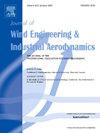Freestream turbulence effects on unsteady wind turbine loads and wakes: An IDDES study
IF 4.9
2区 工程技术
Q1 ENGINEERING, CIVIL
Journal of Wind Engineering and Industrial Aerodynamics
Pub Date : 2025-09-03
DOI:10.1016/j.jweia.2025.106211
引用次数: 0
Abstract
We investigate numerically the effects of freestream turbulence on the unsteady aerodynamics and wakes of the National Renewable Energy Laboratory Phase VI wind turbine rotor for increasing wind speed. Turbulence is modeled using the Improved Delayed Detached-Eddy Simulation (IDDES) method. As a first step, a detailed mesh resolution study is conducted with the decaying freestream turbulence model at turbulence intensity of 0.5%. Our blade-resolved IDDES simulations show that grid-independent average torque and thrust results can be achieved with relatively coarse meshes, whereas dramatically higher mesh resolution is required for grid-independent results for power spectral densities of thrust force, especially in the deep-stall regime. Comparing the loads with the Shear-Stress Transport model demonstrates the superiority of IDDES in predicting massively separated flows. The aerodynamic performance and wake predictions with the decaying freestream turbulence model are compared with the synthetic freestream turbulence model. Both models predict nearly the same loads, spectral energy content, and wake characteristics. The properties of both the near- and far-wake regions are then examined. We show that separated boundary layers accelerate turbulent mixing and entrainment of the external flow, which results in faster wake recovery. The effect of increasing turbulence intensity to 6% is investigated using the synthetic freestream turbulence model. In contrast with the fully attached boundary layer, higher freestream turbulence in deep stall does not significantly affect the loads and vortex-shedding characteristics. However, the turbulent mixing in the wake is enhanced, which further hastens the recovery of the self-similar velocity profile. In general, increasing the wind speed at high turbulence intensity shifts the recovery farther upstream and increases the wake width.
自由流湍流对非定常风力机负荷和尾迹的影响:IDDES研究
数值研究了自由流湍流对国家可再生能源实验室第六期风力发电机转子非定常空气动力学和尾迹的影响。采用改进的延迟分离涡模拟(IDDES)方法对湍流进行了建模。首先,对湍流强度为0.5%时的衰减自由流湍流模型进行了详细的网格分辨率研究。我们的叶片分辨率IDDES模拟表明,相对粗糙的网格可以获得与网格无关的平均扭矩和推力结果,而推力功率谱密度的网格无关结果需要更高的网格分辨率,特别是在深失速状态下。将载荷与剪切应力输运模型进行比较,证明了IDDES在预测大规模分离流动方面的优越性。将衰减自由流湍流模型与合成自由流湍流模型的气动性能和尾迹预测进行了比较。两种模型预测的载荷、谱能量含量和尾迹特性几乎相同。然后检查了近尾流和远尾流区域的特性。我们表明,分离的边界层加速了湍流混合和外部流动的夹带,从而导致更快的尾迹恢复。利用合成自由流湍流模型研究了湍流强度增加到6%的效果。与完全附著的边界层相比,深度失速时较高的自由流湍流对载荷和旋涡脱落特性的影响并不显著。然而,尾迹中的湍流混合增强,进一步加速了自相似速度剖面的恢复。一般来说,在高湍流强度时增加风速会使恢复向上游移动得更远,并增加尾迹宽度。
本文章由计算机程序翻译,如有差异,请以英文原文为准。
求助全文
约1分钟内获得全文
求助全文
来源期刊
CiteScore
8.90
自引率
22.90%
发文量
306
审稿时长
4.4 months
期刊介绍:
The objective of the journal is to provide a means for the publication and interchange of information, on an international basis, on all those aspects of wind engineering that are included in the activities of the International Association for Wind Engineering http://www.iawe.org/. These are: social and economic impact of wind effects; wind characteristics and structure, local wind environments, wind loads and structural response, diffusion, pollutant dispersion and matter transport, wind effects on building heat loss and ventilation, wind effects on transport systems, aerodynamic aspects of wind energy generation, and codification of wind effects.
Papers on these subjects describing full-scale measurements, wind-tunnel simulation studies, computational or theoretical methods are published, as well as papers dealing with the development of techniques and apparatus for wind engineering experiments.

 求助内容:
求助内容: 应助结果提醒方式:
应助结果提醒方式:


